Tomorrow, March 1, 2014, is the 60th anniversary of the Castle Bravo nuclear test. I’ve written about it several times before, but I figured a discussion of why Bravo matters was always welcome. Bravo was the first test of a deliverable hydrogen bomb by the United States, proving that you could not only make nuclear weapons that had explosive yields a thousand times more powerful than the Hiroshima bomb, but that you could make them in small-enough packages that they could fit onto airplanes. It is was what truly inaugurated the megaton age (more so than the first H-bomb test, Ivy Mike, which was explosively large but still in a bulky, experimental form). As a technical demonstration it would be historically important even if nothing else had happened.

One of the early Castle Bravo fallout contours showing accumulated doses. Source.
But nobody says something like that unless other things — terrible things — did happen. Two things went wrong. The first is that the bomb was even more explosive than the scientists thought it was going to be. Instead of 6 megatons of yield, it produced 15 megatons of yield, an error of 250%, which matters when you are talking about millions of tons of TNT. The technical error, in retrospect, reveals how grasping their knowledge still was: the bomb contained two isotopes of lithium in the fusion component of the design, and the designers assumed only one of them would be reactive, but they were wrong. The second problem is that the wind changed. Instead of carrying the copious radioactive fallout that such a weapon would produce over the open ocean, where it would be relatively harmless, it instead carried it over inhabited atolls in the Marshall Islands. This necessitated evacuation, long-term health monitoring, and produced terrible long-term health outcomes for many of the people on those islands.
If it had just been natives who were exposed, the Atomic Energy Commission might have been able to keep things hushed up for awhile — but it wasn’t. A Japanese fishing boat, ironically named the Fortunate Dragon, drifted into the fallout plume as well and returned home sick and with a cargo of radioactive tuna. One of the fishermen later died (whether that was because of the fallout exposure or because of the treatment regime is apparently still a controversial point). It became a major site of diplomatic incident between Japan, who resented once again having the distinction of having been irradiated by the United States, and this meant that Bravo became extremely public. Suddenly the United States was, for the first time, admitting it had the capability to make multi-megaton weapons. Suddenly it was having to release information about long-distance, long-term contamination. Suddenly fallout was in the public mind — and its popular culture manifestations (Godzilla, On the Beach) soon followed.
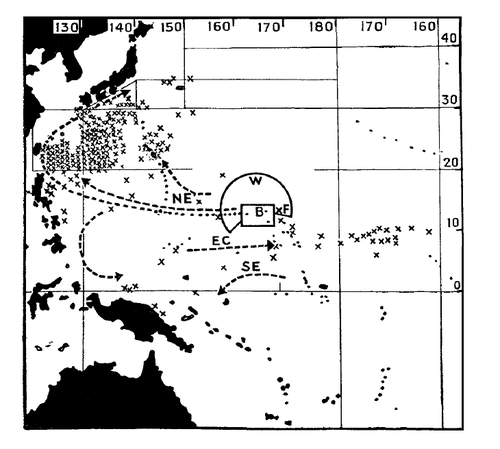
Map showing points (X) where contaminated fish were caught or where the sea was found to be unusually radioactive, following the Castle Bravo nuclear test. This sort of thing gets public attention.
But it’s not just the public who started thinking about fallout differently. The Atomic Energy Commission wasn’t new to the idea of fallout — they had measured the plume from the Trinity test in 1945, and knew that ground bursts produced radioactive debris.
So you’d think that they’d have made lots of fallout studies prior to Castle. I had thought about producing some kind of map with all of the various fallout plumes through the 1950s superimposed on it, but it became harder than I thought — there are just a lot fewer fallout plumes prior to Bravo than you might expect. Why? Because prior to Bravo, they generally did not map downwind fallout plumes for shots in Marshall Islands — they only mapped upwind plumes. So you get results like this for Ivy Mike, a very “dirty” 10.4 megaton explosion that did produce copious fallout, but you’d never know it from this map:
To make it even more clear what you’re looking at here: the wind in this shot was blowing north — so most of the fallout went north. But they only mapped the fallout that went south, a tiny amount of the total fallout. So it looks much, much more contained than it was in reality. You want to shake these guys, retrospectively.
It’s not that they didn’t know that fallout went further downwind. They had mapped the Trinity test’s long-range fallout in some detail, and starting with Operation Buster (1951) they had started mapping downwind plumes for lots of tests that took place at the Nevada Test Site. But for ocean shots, they didn’t their logistics together, because, you know, the ocean is big. Such is one of the terrible ironies of Bravo: we know its downwind fallout plume well because it went over (inhabited) land, and otherwise they probably wouldn’t have bothered measuring it.
The publicity given to Bravo meant that its fallout plume got wide, wide dissemination — unlike the Trinity test’s plume, unlike the other ones they were creating. In fact, as I mentioned before, there were a few “competing” drawings of the fallout cloud circulating internally, because fallout extrapolation is non-trivially difficult:
But once these sorts of things were part of the public discourse, it was easy to start imposing them onto other contexts beyond islands in the Pacific Ocean. They were superimposed on the Eastern Seaboard, of course. They became a stock trope for talking about what nuclear war was going to do to the country if it happened. The term “fallout,” which was not used even by the government scientists as a noun until around 1948, 1 suddenly took off in popular usage:
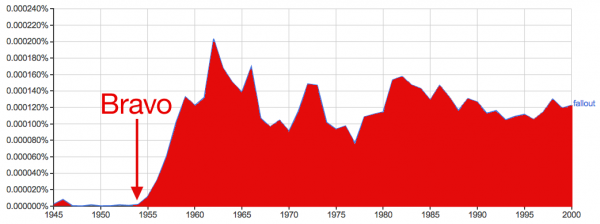
Google Ngram chart of the usage of the word “fallout” in English language books and periodicals. Source.
The significance of fallout is that it threatens and contaminates vast areas — far more vast than the areas immediately affected by the bombs themselves. It means that even a large-scale nuclear attack that tries to only threaten military sites is also going to do both short-term and long-term damage to civilian populations. (As if anyone really considered just attacking military sites, though; everything I have read suggests that this kind of counter-force strategy was never implemented by the US government even if it was talked about.)
It meant that there was little escaping the consequences of a large nuclear exchange. Sure, there are a few blank areas on maps like this one, but think of all the people, all the cities, all the industries that are within the blackened areas of the map:
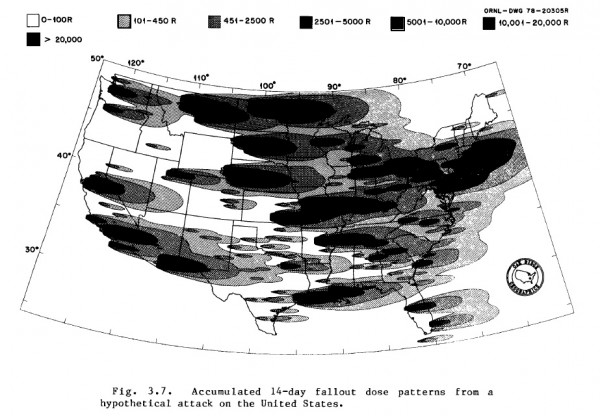
Oak Ridge National Laboratory estimate of “accumulated 14-day fallout dose patterns from a hypothetical attack on the United States,” 1986. I would note that these are very high exposures and I’m a little skeptical of them, but in any case, it represents the kind of messages that were being given on this issue. Source.
Bravo inaugurated a new awareness of nuclear danger, and arguably, a new era of actual danger itself, when the weapons got big, radiologically “dirty,” and contaminating. Today they are much smaller, though still dirty and contaminating.
I can’t help but feel, though, that while transporting the Bravo-like fallout patterns to other countries is a good way to get a sense of their size and importance, that it still misses something. I recently saw this video that Scott Carson posted to his Twitter account of a young Marshallese woman eloquently expressing her rage about the contamination of her homeland, at the fact that people were more concerned about the exposure of goats and pigs to nuclear effects than they were the islanders:
I’ve spent a lot of time looking at the reports of the long-term health effects on the Marshallese people. It is always presented as a cold, hard science — sometimes even as a “benefit” to the people exposed (hey, they got free health care for life). Here’s how the accident was initially discussed in a closed session of the Congressional Joint Committee on Atomic Energy, for example:
Chairman Cole: “I understand even after they [the natives of Rongelap] are taken back you plan to have medical people in attendance.”
Dr. Bugher: “I think we will have to have a continuing study program for an indefinite time.”
Rep. James Van Zandt: “The natives ought to benefit — they got a couple of good baths.”
Which is a pretty sick way to talk about an accident like this, even if all of the facts aren’t in yet. Even for a classified hearing.
What’s the legacy of Bravo, then? For most of us, it was a portent of dangers to come, a peak into the dark dealings that the arms race was developing. But for the people on those islands, it meant that “the Marshall Islands” would always be followed by “where the United States tested 67 nuclear weapons” and a terrible story about technical hubris, radioactive contamination, and long-term health problems. I imagine that people from these islands and people who grew up near Chernobyl probably have similar, terrible conversations.

A medical inspection of a Marshallese woman by an American doctor. “Project 4,” the biomedical effects program of Operation Castle was initially planned to be concerned with “mainly neutron dosimetry with mice” but after the accident an additional group, Project 4.1, was added to study the long-term exposure effects in human beings — the Marshallese. Image source.
I get why the people who made and tested the bombs did what they did, what their priorities were, what they thought hung in the balance. But I also get why people would find their actions a terrible thing. I have seen people say, in a flip way, that there were “necessary sacrifices” for the security that the bomb is supposed to have brought the world. That may be so — though I think one should consult the “sacrifices” in question before passing that judgment. But however one thinks of it, one must acknowledge that the costs were high.
- William R. Kennedy, Jr., “Fallout Forecasting—1945 through 1962,” LA-10605-MS (March 1986), on 5.[↩]
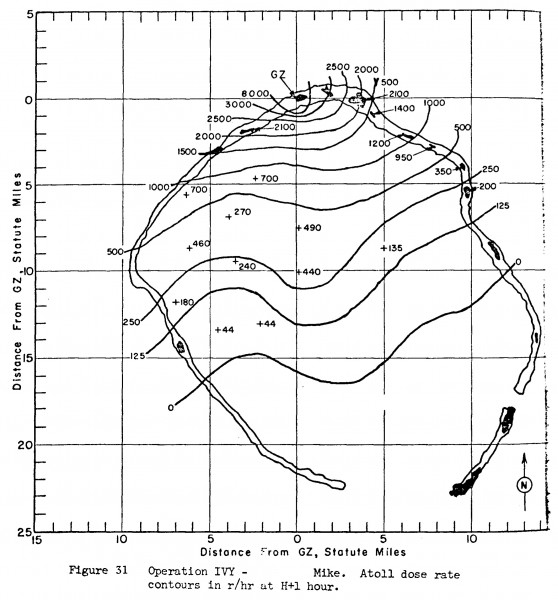
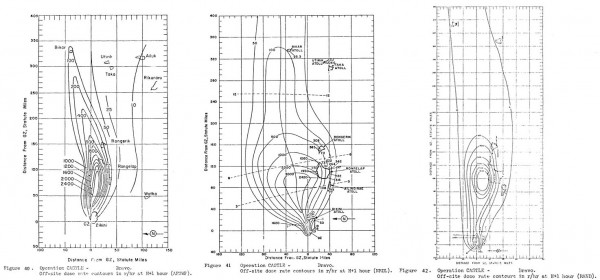


Your unmentioned purposes of the testing need to be stated clearly – this was the Cold WAR. If we hadn’t won, it would have mean decades of slavery for hundreds of millions.
There were costs all around in this struggle. Military pilots of the era suffered 2% annual losses from just training; submarines vanished – Thrasher and Scorpion. Industrial accidents at naval shipyards; munitions manufacturing plants exploded.
So yes, our hearts go out to the Marshallese but please don’t let yourself get maudlin.
Aside from the fallacy of your lumping in volunteer military members with unvolunteered civilians (much less the bizarre idea the only alternative to irradiating civilian populations was “slavery”), I just want to note that the purposes of the testing are not only not “unmentioned,” they are in the first paragraph. If you are going to be bothered to respond, please bother to read it. I’m not trying to be, and I don’t think I have been, “maudlin.” You say your heart goes out to the Marshallese, but your flip way of talking about the situation suggests otherwise. I suspect you would see it differently if this was your home we were talking about, instead of theirs.
The problem is that it is all too easy for governments to convince the gullible that ANY sacrifice is necessary because of some perceived threat. When there is no threat, they invent one or blow one out of proportion to ensure that they have a reason to keep the chains of power binding their populations. I am not saying that there was no threat from the Soviets. Clearly there was a threat. However, that doesn’t justify hundreds of atmospheric tests that wound up releasing long lived fission isotopes over large portions of the planet. They should maybe have tested a small number of them to prove the concept and then left it alone. Sadly though, they didn’t and people were harmed and are continuing to be harmed because of the legacy of nuclear power and weapons. There are many places in the former USSR that are heavily contaminated but, due to the collapse of the USSR, are now easily accessed by the population and many no longer have so much as a barbed wire fence to keep people out.
There was nothing maudlin in this post. A fighter pilot is a volunteer, a Marshallese child? Not so much. 😉
Yeah, nothing maudlin here, plenty of irony and much needed perspectives on the oft cited “necessary sacrifices” which remain with us today with PRISM etc.
Really enjoyed the post. I have been lurking for over a year and have always enjoyed that this is usually a place where the below the line comments are usually considered and add something to the conversation rather than the type of thing above. Keep up the great work!
Just stirring the pot a little … it could be that the Marshallese have gotten more sympathy than would otherwise be the case because they were (and are) a fairly poor bunch. Not that that should make them any more deserving, but it does.
I think it’s more that they were clearly never going to share in any of the benefits of developing those weapons.
http://www.artificialowl.net/2008/11/nuclear-trash-can-of-pacific-on.html
http://www.artificialowl.net/2008/12/castle-bravo-biggest-usa-atomic-bomb.html
Daigo Fukuryumaru (the Fifth Lucky Dragon)
—Provide some context: why was it translated as “fifth” Lucky Dragon? It was the fifth boat in a fleet? The crew had owned four previous boats? “Fifth Luck Dragon” has some kind of context?
http://darumamuseumgallery.blogspot.com/2007/06/fifth-lucky-dragon.html
Extremely interesting and well written piece here. I also researched this event for my thriller CASTLE BRAVO (Yes, I named the novel for this test) which focuses on survivors/descendants of these tests but also traces what the Soviets did to the citizens of Kazakhstan with their atmospheric testing (much more brutal). I wrote it as a novel I hoped people would read and enjoy and yet understand this important piece of history. After all it was George Bernard Shaw who said, “The best way to get your point across is to entertain.” Best to you….K.
Whitehall is incorrect, in regards to the Scorpion. Author Ed Offley, in his comprehensive volume, “Scorpion Down: Sunk by the Soviets, Buried by the Pentagon” the US sub was, as the title hints at, sunk by the Russians.
During the latter part of the 1960s, the Brezhnev regime engaged in a series of very provacative acts that were–directly–acts of war. But LBJ decided to not take the next steps on that.
[…] Castle Bravo at 60 (The Nuclear Secrecy Blog) […]
Does any footage of Castle Bravo’s early fireball exist?
Seen as this is the most closely related post, I was wondering if Alex W has any information on the story behind the intentional ambiguity on the identity of the following Operation Castle footage of a fireball seen from 0:50 until 1:15
https://archive.org/details/MilitaryEffectsStudiesonOperationCastle1954
Note the narrator only labels the footage after the cut to the mushroom cloud (1:17) as Bravo, he refrains from labeling the earlier fireball footage itself as that of Bravo.
This ambiguity resulted in the Peter Kuran Documentary “Trinity and Beyond”* labeling the fireball as being the Castle Bravo test. However the islands surrounding the footage, namely the spear head shaped Bogon Island, clearly indicate that it is in fact most certainly shot Castle NECTAR and not Bravo.
* Trinity and Beyond, the fireball footage, remastered, can be witnessed from 0:40, and the “Castle Bravo” label is seen at 2:20. Now although the footage at that time(2:20) is of a mushroom cloud cap, and may well be Bravo’s mushroom cap, the earlier fireball footage at 0:40 onwards is, I think, misleadingly, not of Bravo.
https://www.youtube.com/watch?v=PvDvN5oYoZw
This mislabeling of the Nectar test shot as the Bravo event seems to be getting endemic. However there are no known military sources that I know of that unequivocally label the fireball footage as either Nectar or Bravo, or some other shot entirely.
I engaged in a debate on the Enewetak atoll talk page of wikipedia recently and despite my, and a friends efforts to find a primary source that labels the fireball footage, we frustratingly came up empty.
https://en.wikipedia.org/wiki/Talk:Enewetak_Atoll#Castle_video_under_question.2C_is_it_shot_Nectar_or_Bravo.3F
Any pointers on finding a primary source that unambiguously labels the fireball footage would be appreciated,
Tom